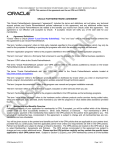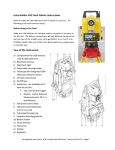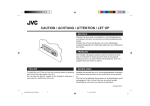Download Laboratory Procedures and Safety
Transcript
SAN FRANCISCO STATE UNIVERSITY ELECTRICAL ENGINEERING ENGR 206 Laboratory Procedures and Safety Objective To discuss and become aware of laboratory procedures, requirements, and safety practices. Attendance 1. Each student must attend all lab sessions. Attendance is factored into the final grade. 2. Contact instructor in advance if you have a valid reason to miss a laboratory period. 3. No credit for late labs. Introduction A successful laboratory experiment involves four properly executed steps: 1. Design an efficient and effective experimental procedure and setup. Students must study the lab manual before coming to the lab and know what is to be done and what is the expected outcome. 2. Connect circuits carefully and systematically and operate laboratory equipment with knowledge and skill. Read user's manual and learn not only how to operate the apparatus but also its capabilities and limitations. Parts of user's manuals for instruments used in this lab are included in the handouts. As with any other type of skill, hands-on experience is essential in developing proficiency so each student must take turns to actually operate each instrument. 3. Record data clearly and completely, including units, scales, instrument settings, etc. so that the measurement can be repeated, if necessary. Keep meticulous notes; do not trust your memory to fill-in some parts later. While recording data, check if they are in general agreement with theoretical predictions. If not, try to find out why such as by rechecking theoretical calculations and/or experimental procedure and setup. 4. Report what was done and what results were obtained. Explain the significance of the experiment and discrepancies with theory, if any. 1 Engr 206 Lab Procedures Format for Lab Reports Semi-formal reports are required for this course. All reports must be in Word format. The lab steps must be numbered to correspond with the lab assignment. Graphs and diagrams should be computer generated or done with the aid of drafting tools. The report must include the following items: 1. 2. 3. 4. Cover page (see Appendix C) Objectives Apparatus and components used Procedures, experimental set-ups, data, sample calculations and results. The organization should step 4 and 5 is to be combined be systematic and logical. Use graphs, tables, and lab step numbered and charts wherever possible. Avoid unnecessary duplications. 5. Correlation between theory and experimental results (included in item 4 above) 6. Conclusions and discussions 7. References 8. Appendices 9. ALL LAB NOTES MUST BE ATTACHED! No credit without lab notes. 10. Lab reports to be emailed to [email protected] on due date also paper copy is necessary. Laboratory Regulations To assure smooth running of the laboratory, the following rules must be observed by all students. Violations of these rules will result in penalties (points off or other disciplinary actions). 1. Each student must attend all lab sessions. 2. All equipment must be handled with great care. Never pull a cord by grabbing the wire -- grab the plug instead. 3. Notify the instructor immediately for any damaged or malfunctioning equipment. 4. Laboratory must be kept clean. No eating, drinking, or smoking in the lab. 5. Always come to the lab well prepared. Pre-lab work must be completed before coming to the lab. 6. Observe all safety rules. No horseplay in the lab. 7. Lab reports are due any time on their specified due dates and must be emailed to [email protected]. 2 Engr 206 Lab Procedures Laboratory Safety Practices Observing laboratory safety precautions is perhaps more important than anything else you do in the laboratory for your life may depend on it. It is extremely important that you develop a safety-minded laboratory habit. Accidents do happen even in a "low" voltage laboratory such as this one. The most dangerous safety problem in an electrical laboratory is electric shock. It is the result of passing electric current through a human body. It takes only 0.02 A to cause muscular contractions and 0.1 A to produce breathing difficulties and severe shock. The severity of an electric shock varies somewhat from individual to individual and is a function of both current and time. General electrical safety practices: 1. Keep all equipment properly grounded. 2. Avoid handling of exposed leads and conductors. 3. Shut off all power sources before touching any part of a circuit. 4. Keep yourself dry. 5. Wear a pair of shoes and avoid wearing anything metal, including jewelry. 6. Know what you are doing and pay attention to what you are doing. In case of electric shock, the immediate thing to do is to remove the power source from the victim without endangering oneself. Do not touch the victim with bare hands while the victim is still connected to the power source. If the victim has stopped breathing, administer artificial respiration until directed otherwise by medical professionals. 3 Engr 206 Lab Procedures Measurement Terms Four often used terms in laboratory measurement are explained here. Learn the precise meaning of each and use them correctly. Accuracy is a measure of freedom from error. An error is the difference between the measured and the true value of a quantity. An error is often expressed in percent: % error = true value - measured value x 100 true value Since the true value is usually unknown, the theoretical value or the value obtained by calibrated, high-accuracy instrument is generally used as the reference instead. Many factors can cause measurement errors. They can be grouped into four major categories: human error, equipment error, environmental error, and random error. Precision is a measure of exactness. A 6-place math table is more precise than a 4-place table but may be less accurate if the 6-place table contains error. Similarly, an instrument that displays more digits is more precise but not necessarily more accurate. Resolution is a measure of significance of the least significant digit. It is the smallest distinguishable increment that can be measured. For example, a voltmeter that displays voltage between 0.000 and 9.999 volts has a resolution of 0.001 V. However, not all digits provided by an instrument are necessarily meaningful. Some less significant digits could represent random noise more than the actual signal. 4 Engr 206 Lab Procedures Plagiarism You are expected to behave professionally and ethically. You will be treated as an engineer. It is expected that lab partners will have the same data and similar organizations for their lab reports. Identical Procedures and Conclusions are NOT acceptable. Any work which appears to be Cloned, or otherwise overly-similar to another’s work will be assumed to be plagiarized. Plagiarism is a form of cheating or fraud; it occurs when a student misrepresents the work of another as his or her own. Plagiarism may consist of using the ideas, sentences, paragraphs, whole text, graphs, plots, and/or schematics of someone else without appropriate acknowledgment, but it also includes employing or allowing another person to write or substantially alter work that a student then submits as his or her own. Any assignment found to be plagiarized will be given an “F” grade, and you will not be allowed to resubmit the assignment. If applicable, an “F” grade will also be given to the students that allowed their work to be copied. All instances of plagiarism in the School of Engineering will be reported to the Director of the School of Engineering, and may be reported to the University Judicial Affairs Officer for further action. The instance of plagiarism will be part of your permanent student record. 5 Engr 206 Lab Procedures Appendix A: Lab Report Cover Sheet SAN FRANCISCO STATE UNIVERSITY ELECTRICAL ENGINEERING ENGR 206.[section] Lab Report Date Experiment # [ ] [experiment title] Written by [ Name ] Lab Partners: [ Name ] 6 Engr 206 Lab Procedures Appendix B: Resistor Color Code 1st band 1st digit 3rd band Multiplier 4th band Tolerance 2nd band 2nd digit Color Black Digit 0 Multiplier 1 Tolerance - Preferred number series 10 15 22 33 47 68 11 12 13 10 16 18 20 15 24 27 30 22 36 39 43 33 51 56 62 47 75 82 91 68 12 10 18 15 27 22 39 33 56 47 82 68 ± 5% tolerance Brown Red Orange Yellow 1 2 3 4 10 100 1,000 10,000 - Green Blue 5 6 100,000 1,000,000 - Violet 7 - Gray White Gold Silver No color 8 9 - 10,000,00 0 0.1 0.01 - ± 10% tolerance ± 20% tolerance ± 5% ± 10% ± 20% 7 Appendix D Resistor Color Code Appendix C: Capacitors There are many different types of capacitors depending on the dielectric material used. Commonly used ones are: ceramic, electrolytic, mica, mylar, paper, and polystyrene. You have ceramic and electrolytic capacitors in your kit. Ceramic disk capacitor A Ceramic disc capacitor (pictured above) is formed by a ceramic plate with metal coatings on both sides. Leads are attached to the metal coatings for external connections. Disc capacitors have their values printed on the body. However, sometimes the body is too small to print both the value and the unit so abbreviated notations may be used. In the EIA code, values are specified in pF by whole numbers or in μF by decimal numbers. There are only two significant digits in whole numbers. If there is a third digit, it represents a power of 10 multiplication factor. For example, a three digit number 104 represents 10 (the first two digits) times 10 to the 4th power (the third digit), in pF. Thus, 104 means 100000 pF, or 0.1 μF. If the number printed on the capacitor is .1, it also means 0.1 μF. Electrolytic capacitor “+” terminal 35V 22 μF An electrolytic capacitor such as the one shown above is formed by two aluminum foils, one with an oxide coating, and conducting electrolyte in between. The side with oxide is the positive electrode. This is indicated by a "+" mark and/or a constriction on the package. Alternatively (Japanese type), a "-" sign with an arrow is used to point to the negative terminal. Unlike the disc ceramic capacitor, the electrolytic capacitor is polarity sensitive. They must be connected in the circuit with correct polarities. That is, the "+" side of the capacitor should be at a higher average potential than that of the "-" side. The capacitor may be damaged if the connections are reversed. The capacitance value is printed on the package. In addition to the capacitance value there are usually other coded information representing tolerance, temperature characteristics, and voltage rating. 8
















